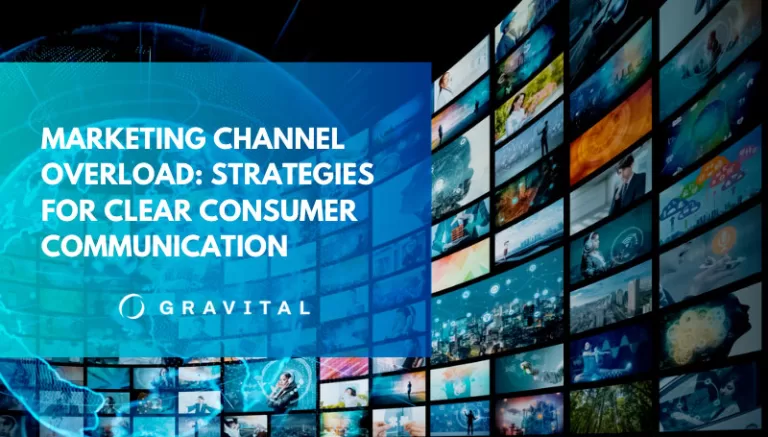Consumers today are constantly besieged by marketing messages. They encounter ads on social media, emails in their inbox, pop-ups on websites, and even sponsored content while watching videos or listening to music. While having multiple marketing channels to reach your audience can be powerful, there’s a fine line between effective outreach and overwhelming your customers.
Too much exposure, inconsistent messaging and disjointed experiences can lead to consumer confusion. The challenge for marketers is to strike a balance, ensuring that consumers remain engaged and understand the message without feeling assailed. This blog post will explore how to address consumer confusion by developing a sound marketing channel strategy.
Too Many Channels: A Recipe for Confusion
While more channels mean more opportunities to reach potential customers, too many channels without proper coordination can create a cluttered and confusing experience for consumers.
When brands try to be everywhere all at once, they risk overwhelming their audience, leading to disengagement. This oversaturation of marketing messages makes it difficult for consumers to know where to focus their attention, which can dilute the impact of campaigns and lower conversion rates.
Brands and marketers must be intentional with their choice of channels and ensure that each platform serves a distinct purpose within the broader strategy. A clear and targeted approach across the right channels can cut through the noise, making it easier for consumers to connect with the brand.
ALSO READ: The 5 Highest ROI Digital Marketing Channels
Reasons for Confusion
Consumers today face an overload of information, and the consequences are often confusion, frustration, and disconnection. Here are the primary reasons consumers may feel overwhelmed by marketing efforts:
Information Overload
Consumers receive a constant stream of information from multiple sources, often within seconds or minutes. This can lead to difficulty processing and prioritizing which messages matter most. As a result, many customers simply tune out, making it harder for brands to make a lasting impression.
A consumer may receive marketing emails, see social media posts, and watch a video ad—all promoting the same product. While repetition is sometimes effective, too much exposure can cause the customer to become indifferent.
Inconsistent Messaging
When a brand presents different messaging across various channels, it creates confusion. If one message highlights product features while another focuses on pricing, consumers may not understand the brand’s core value proposition. Inconsistent messaging also makes it difficult for consumers to know what to expect, which can erode trust.
For example, a retail brand offering a 20% discount in one ad but failing to mention it in follow-up communications or in-store promotions creates an uneven and confusing experience.
Ad Fatigue
Seeing the same ad too often can lead to ad fatigue, where the consumer becomes so accustomed to the message that they start ignoring it. While frequency is key to brand recall, there is a tipping point where too much exposure diminishes engagement.
When consumers scroll through Instagram or Facebook and see the same ad multiple times a day for a week, they eventually stop paying attention and may even unfollow the brand.
Channel Overload
With so many marketing channels available—from email and social media to podcasts and video ads—consumers are being targeted from every direction. This bombardment can lead to disengagement as customers find it challenging to sort through all the noise.
Lack of Personalization
Generic, one-size-fits-all marketing messages make consumers feel like just another number. In an era where personalization is expected, failing to tailor communications to individual preferences or behavior can lead to disengagement.
Example: Sending a promotional email about winter coats to someone who lives in a warm climate and has never purchased cold-weather gear can feel irrelevant, leaving the consumer confused about the brand’s relevance to their needs.


5 Solutions for Consumer Confusion
To combat the confusion that too many marketing channels can create, brands must take strategic steps to simplify their communication efforts. Here are some tips to consider:
1. Identify the Most Effective Channels
Not every platform is the right fit for every brand. It’s crucial to understand where your target audience spends their time and focus your efforts on the channels that will have the most impact. Concentrating on the right channels will reduce unnecessary noise and ensure that your message reaches the right audience.
Solution: Instead of spreading your efforts across 10 platforms, for example, focus on two or three that drive the most engagement for your audience, such as Instagram and email marketing for fashion brands.
ALSO READ: The Power of Sales Enablement
2. Create Consistent Messaging
Consistency is key to reducing confusion. Ensure that the message you deliver is aligned across all platforms, even if you adapt the format to suit the specific channel. The brand’s tone, value proposition and core messages should remain the same.
3. Limit Exposure
Frequency is important, but balance is critical. Avoid oversaturating your audience with the same message too often. Use data to identify optimal times for sending messages, and spread them out to prevent ad fatigue.
Instead of bombarding your audience with daily emails about a sale, consider sending reminders at strategic points in the customer journey, such as a launch announcement, a mid-sale reminder and a final call.
4. Personalize the Experience
Personalization can cut through the clutter by delivering messages that are relevant to each individual consumer. Use data-driven strategies to tailor content, product recommendations and promotions to your customer’s preferences and behaviors.
For example, an e-commerce brand can use past purchase history to recommend related products, ensuring that the communication feels relevant and personalized to the customer’s interests.
5. Optimize Each Channel for Its Strengths
Each channel has its unique strengths, and brands should take advantage of these to enhance the user experience. For instance, Instagram is highly visual and perfect for product showcases, while email is more suitable for in-depth promotions or personalized offers.
Final Words
Marketing through multiple channels is necessary, but without a strategy, it can confuse and overwhelm your audience. By identifying the most effective channels, ensuring consistent messaging, and personalizing the experience, brands can cut through the noise and build stronger connections with their customers.
At Gravital, we understand that crafting a clear, focused marketing strategy can be challenging, but it’s necessary. Reach out to us today, and we’ll help you design a marketing channel strategy that makes sense for your brand and your customers.


